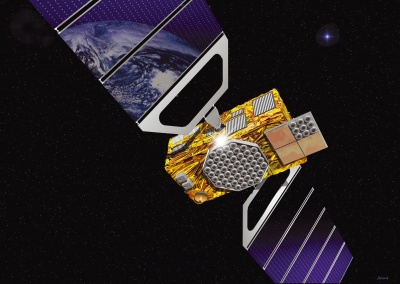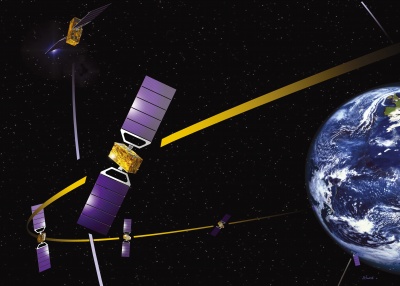If you wish to contribute or participate in the discussions about articles you are invited to contact the Editor
Galileo
| GALILEO | |
|---|---|
| Title | Galileo |
| Author(s) | GMV |
| Level | Basic |
| Year of Publication | 2000 |
Introduction
The Galileo Space Segment will comprise a constellation of a total of 30 Medium Earth Orbit (MEO) satellites, of which 3 are spares, in a so-called Walker 27/3/1 constellation[footnotes 1]
Each satellite will broadcast precise time signals, ephemeris and other data. The Galileo satellite constellation has been optimised to the following nominal constellation specifications:
- circular orbits (satellite altitude of 23 222 km)
- orbital inclination of 56°
- three equally spaced orbital planes
- nine operational satellites, equally spaced in each plane
- one spare satellite (also transmitting) in each plane
The Galileo satellite is a 700 kg/1600 W class satellite.
The image shows an artist's impression of a Galileo spacecraft in orbit with solar arrays deployed. The spacecraft rotates about its Earth-pointing axis so that the flat surface of the solar arrays always faces the Sun to collect maximum solar energy. The antennas, shown on the underside of the body in the picture, always point towards the Earth. The spacecraft body will measure 2.7 m x 1.1 m x 1.2 m and the deployed solar arrays span 13 m.
Satellite components
The L-band antenna transmits the navigation signals in the 1200-1600 MHz frequency range.
The SAR (Search and Rescue) antenna picks up distress signals from beacons on Earth and transmits them to a ground station for forwarding to local rescue services.
The C-band antenna receives signals containing mission data from Galileo Uplink Stations. This includes data to synchronise the on-board clocks with a ground-based reference clock and integrity data which contains information about how well each satellite is functioning. The integrity information is incorporated into the navigation signal for transmission to users.
Two S-band antennas are part of the telemetry, tracking and command subsystem. They transmit housekeeping data about the payload and spacecraft to ground control and, in turn, receive commands to control the spacecraft and operate the payload. The S-band antennas also receive, process and transmit ranging signals that measure the satellite's altitude to within a few metres.
The infrared Earth sensors and the Sun sensors both help to keep the spacecraft pointing at the Earth. The infrared Earth sensors do this by detecting the contrast between the cold of deep space and the heat of the Earth's atmosphere. The Sun sensors are visible light detectors which measure angles between their mounting base and incident sunlight.
The laser retro-reflector allows the measurement of the satellite's altitude to within a few centimetres by reflecting a laser beam transmitted by a ground station. The laser retro-reflector is used only about once a year, as altitude measurements via S-band antenna ranging signals are otherwise accurate enough.
The space radiators are heat exchangers that radiate waste heat, produced by the units inside the spacecraft, to deep space and thus help to keep the units within their operational temperature range.
- REDIRECT Galileo Space Segment
Interior: service module
- SADM is the drive mechanism that connects the solar arrays to the spacecraft and rotates them slowly so that the surface of the arrays can remain perpendicular to the Sun's rays at all times.
- The gyroscopes measure the rotation of the spacecraft.
- The reaction wheels control the rotation of the spacecraft. When they rotate, so does the spacecraft. It rotates twice per orbit to allow the solar arrays to remain parallel to the Sun's rays.
- The magneto bar modifies the speed of rotation of the reaction wheels by introducing a torque (turning force) in the opposite direction.
- The power conditioning and distribution unit regulates and controls power from the solar arrays and batteries and distributes it to all the spacecraft's subsystems and payload.
- The environmental monitoring unit on-board provides radiation measurements
- The on-board computer controls all aspects of spacecraft and payload functioning.
Satellite facts and figures
| Spacecraft facts and figures | |
|---|---|
| Spacecraft bus dimensions | 2.7 x 1.1 x 1.2 m |
| Solar array span | 13m |
| Peak power | 1600 W |
| Navigation signals | 10 signals transmitted in 1200-1600 MHz range |
| Launch mass | 700kg |
Notes
- ^ A Walker Delta 56°:27/3/1 constellation, which means there are 27 satellites in 3 planes inclined at 56 degrees, spanning the 360 degrees around the equator.


